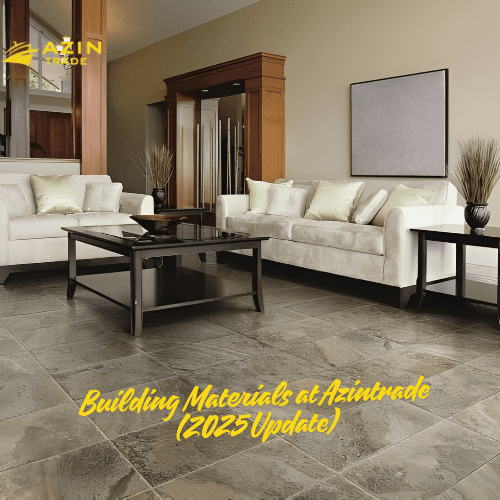Stunning Iranian Porcelain Tiles: Quality, Craftsmanship & Export Insights
A Blend of Heritage and Modern Precision
Iranian porcelain tiles beautifully blend centuries of artistic heritage with modern precision. Thanks to abundant clay resources and a deep-rooted tile-making legacy, Iran has become a notable source of elegant, durable porcelain tiles. Artisans merge traditional Persian designs—like geometric patterns, floral motifs, and calligraphy—with advanced production methods. The result is porcelain tiles that are visually striking, highly functional, and perfect for floors, walls, bathrooms, kitchens, or high-traffic commercial areas.
Top Iranian Porcelain Tile Producers & Exporters
Iran’s porcelain tile sector includes both large-scale factories and artisan studios. Here’s a snapshot of some influential players:
| Company Name | Founded | Specialties & Highlights | Export Trends |
|---|---|---|---|
| Takceram Tile (Isfahan) | — | Produces granite & porcelain tiles using advanced European tech; large annual capacity | Serves domestic & international markets – Araz Tejarat |
| Amin Tile (Meybod) | 2008 | Wide design range, annual output of 9–12 million m² | Growing export presence via quality and design – Araz Tejarat |
| Aras Tile (Isfahan) | — | Modern wall, floor, and porcelain tiles with European machinery | Strong production output (~3 million m²/year) – Araz Tejarat |
| Daya Building Materials | — | Leading exporter of porcelain slabs to Russia, UAE, Europe | Robust exporting with customized logistics – DAYA Building Materials |
📊 Iran produces over 200 million m² of tiles annually, which equals around 40% of its total ceramic tile output—making it the fifth-largest producer and exporter worldwide (ceramland.com, Tehran Times). Yazd province is the heart of the industry, hosting more than 150 active factories and accounting for over half of Iran’s tile production (Tehran Times).
Why Iranian Porcelain Tiles Stand Out
| Advantage | Details |
|---|---|
| Artistic Tradition | Inspired by Persian motifs, Kufic calligraphy, and mosaics—uniquely beautiful (emmetglobal.com, kazempourtile.com) |
| Advanced Quality | High-density, durable, waterproof, stain- and scratch-resistant thanks to high-temp firing (emmetglobal.com) |
| Competitive Prices | Abundant raw materials and skilled labor keep costs competitive compared to Western markets |
| Export Leadership | Iran exports to the Middle East, Russia, Europe, and Central Asia (ceramland.com, DAYA Building Materials) |
| Market Support | Supported by expos like CERAFAIR and government promotion (tile-ceramic-tradefair.ir, Tehran Times) |
Market Trends & Export Outlook
Several trends are shaping Iran’s porcelain tile sector in 2025:
- Export Dynamics: In the past 12 months, Iran shipped over 2,600 export consignments to 339 buyers worldwide—especially in Pakistan, Uzbekistan, and Kazakhstan (ceramland.com). Strong production is possible due to rich mineral resources such as kaolin and feldspar.
- Trade Momentum with Russia: DAYA Building Materials has become a key exporter to Russia, benefiting from reduced tariffs and logistics aligned with Eurasian Economic Union policies.
- Industry Growth & Challenges: Iran’s ceramic tile market, which includes porcelain, is valued at hundreds of millions of USD. Despite sanctions and fluctuating demand, steady growth is expected thanks to urban development (Mordor Intelligence, Verified Market Research).

Best Practices for Sourcing Iranian Porcelain Tiles
- Research & Reach Out: Contact trusted producers such as Takceram, Amin Tile, Aras Tile, or Daya. Always request catalogs, certifications (ISO, CE), and updated pricing.
- Review Samples: Test for density, slip-resistance, finish quality, and accuracy of patterns.
- Check Compliance: Confirm that tiles meet safety and import standards in your market.
- Negotiate Smartly: Discuss costs, order sizes, lead times, and payment methods in detail.
- Plan Logistics: Work with experienced freight providers who understand customs, sanctions, and international trade barriers.
- Leverage Trade Events: Attend expos like CERAFAIR to network with suppliers and explore innovations (tile-ceramic-tradefair.ir).

Export Challenges & Risk Management
While Iran offers strong export opportunities, challenges remain:
- Sanctions & Banking Restrictions: International payments may face limitations.
- Logistical Constraints: Customs delays and infrastructure issues can impact timely delivery.
- Price Volatility: Fluctuating costs of clay, glaze, and energy affect final pricing (Verified Market Research, ).
FAQs about Iranian Porcelain Tiles
1. Are Iranian porcelain tiles suitable for outdoor use?
Yes. Their durability and water resistance make them ideal for patios, balconies, and outdoor walkways.
2. What makes Iranian porcelain tiles different from ceramic tiles?
Porcelain tiles are denser, less porous, and more resistant to stains and scratches compared to standard ceramics.
3. Can I import Iranian porcelain tiles to Europe or the Middle East?
Absolutely. Many exporters already supply Europe, Russia, and Middle Eastern countries, but compliance with local import standards is required.
4. How competitive are Iranian porcelain tile prices internationally?
They are often more affordable than Italian or Spanish tiles due to abundant resources and skilled labor, while still offering high quality.
5. Where can I connect directly with Iranian tile suppliers?
Trade shows such as CERAFAIR in Tehran or platforms like ceramland.com are excellent for direct connections.




